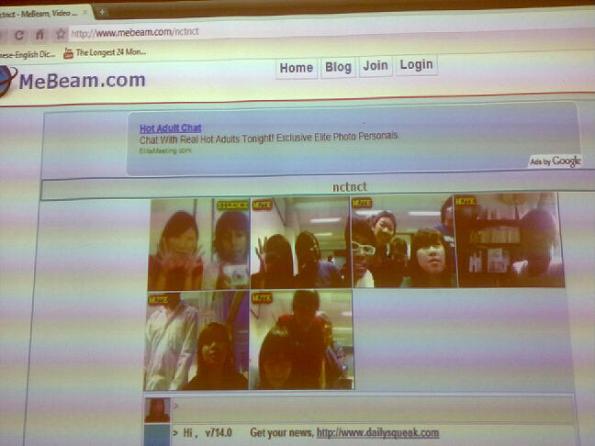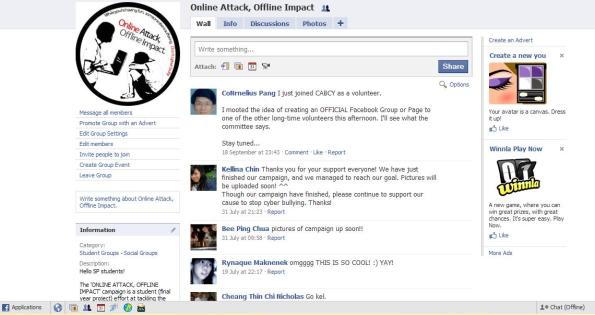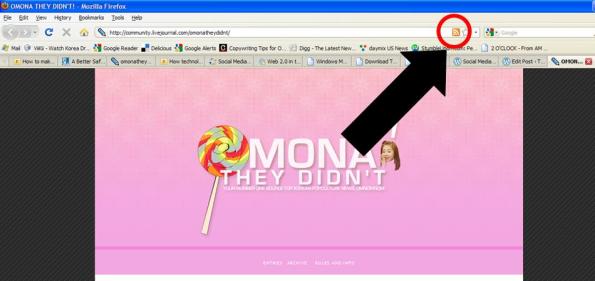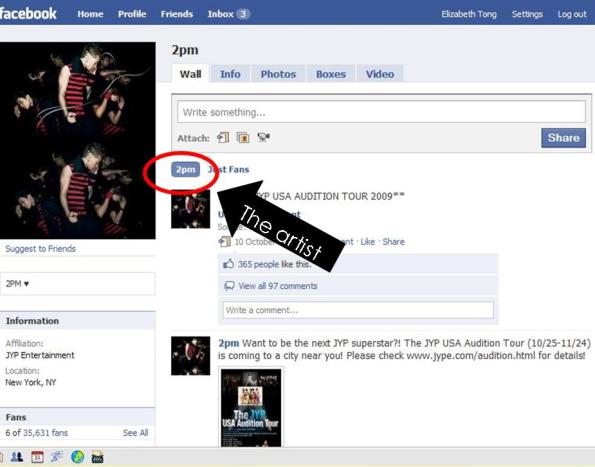What I’m actually talking about is something that we’ve all probably heard about – globalisation.
FYI, globalisation is the integration of economies, societies and cultures through communication. It is a convergence of the world’s resources, ideas, cultures.
This video pretty much sums everything up in a short and succinct manner!
There are 3 different technological stages of globalisation:
Generation 1.0 ( 1492 – 1800):
- Shrank the world from a size large to a size medium.
- Global integration driven by countries and government only.
Generation 2.0 ( 1800 – 2000):
- Shrank the world from a size medium to a size small.
- Global integration driven by multinational companies (MNCs).
Generation 3.0 ( 2001 – present):
- Shrank the world from a small to tiny.
- Global integration driven by individuals.
Living in Generation 3.0 means that in this present day and age,
1. Have easier access to more digital content worldwide. Information is virtually accessible
2. We are all able to go global ourselves, we don’t have to rely on countries, governments or companies to do so.This is facilitated by advances in communication technology and introduction of social media platforms such as instant messaging tools (Windows Live Messenger), video-conferencing softwares (Skype, SightSpeed) , etc.
A video about SightSpeed!
3. We can author our own content in digital form
4. We are able to interact communicate instantaneously with people from all over the world using a variety of digital forms and media, breaking the traditional barriers of language and cultural differences.
Such methods allow us to be connected to each other in ways that were not possible before. For example, photo sharing websites such as Flickr allow people to share their works online without much regard for language differences. Online forums also allow people of similar interests to come together, regardless of cultural and geographical distances.
For myself, I am an active member of several Korean music forums such as 2oneday and Soompi. In these forums, news and information is shared by different users. Desktop wallpaper, avatar and icon designs are also actively shared and critiqued by the forums members. The coming together of these global netizens demonstrates an example of cultural globalisation.
5. There is more global competition. For example, more students in the USA are turning to online tutors from far-off places such as India. Once again, distance is not a factor. They feel that with technology, online tutoring can be as comfortable and effective as physical tutoring.
With technology flattening the global market, anyone with the talent and internet connection has an opportunity to compete in the world’s new level playing field. Physical distance has become immaterial. Our own strengths and capabilities are what sets us apart and empowers ourselves for global integration.
For the 2nd tutorial, Eve, Khalid, Ning and Faith touched on the topic of Social Machines.
They explained what was Continuous Partial Attention (CPA) and the difference between CPA and multitasking by making us play a few games ( like those above).
Another game had us divided into pairs and one person had to reply an SMS while replying to his/her partner next to him/her.
Try these games! They’re supposed to measure how well you multitask!
(LMAO I got dreadfully embarrassing scores. =.=)
- http://www.kongregate.com/games/IcyLime/multitask
- http://www.nytimes.com/interactive/2009/07/19/technology/20090719-driving-game.html
We learnt that multitasking is used when you want to achieve two things at once to increase your productivity. All of us do this tons of times a day. For example, doing mindless stuff such as walking while eating.
CPA, on the other hand, is more like scanning the surface of a few things at once and not really focusing on those things deeply. For example: using your laptop while trying to listen to lecture/tutorial.
CPA could be thought of as a bad way of multitasking, because it decreases your productivity.
Again, all of us have been guilty of this before. We all try to accomplish a few things at once, thinking that by dividing our attention like this, we would be more efficient in completing our work. When in fact, we might even be taking a longer time to finish everything.
Oh well, guess having a “one-track mind” can be good in some cases too.
Social Machines
 Next they taught us about the social news site Digg where people can discover and share content (links, videos, stories, etc) with others. One can also check what are the news that people like the most by looking at the most number of “diggs”. Those that don’t like the Digg article can “bury” it too. Sounds nasty. Hahaha. But this website is also a good example of the wisdom of crowds. Hurhur.
Next they taught us about the social news site Digg where people can discover and share content (links, videos, stories, etc) with others. One can also check what are the news that people like the most by looking at the most number of “diggs”. Those that don’t like the Digg article can “bury” it too. Sounds nasty. Hahaha. But this website is also a good example of the wisdom of crowds. Hurhur.
 Then we moved on to a social bookmarking site, Delicious, where we can bookmark our favourite websites on these sites without changing browsers to access our faves. We can also share our fave websites with others (if we choose to do so) and discover new websites that others have shared.
Then we moved on to a social bookmarking site, Delicious, where we can bookmark our favourite websites on these sites without changing browsers to access our faves. We can also share our fave websites with others (if we choose to do so) and discover new websites that others have shared.
 Having an account at StumbleUpon, another social bookmarking site, also allows for easier discovering and sharing of websites that on your interests. StumbleUpon chooses which Web page to display based on the user’s ratings of previous pages, ratings by his/her friends, and by the ratings of users with similar interests. Users can rate or choose not to rate any Web page with a thumbs up or thumbs down. (Reference)
Having an account at StumbleUpon, another social bookmarking site, also allows for easier discovering and sharing of websites that on your interests. StumbleUpon chooses which Web page to display based on the user’s ratings of previous pages, ratings by his/her friends, and by the ratings of users with similar interests. Users can rate or choose not to rate any Web page with a thumbs up or thumbs down. (Reference)
An example from class:
If you’re a musician and you want people to check out your website for your music, you can pay to have a sponsored page on StumbleUpon. This way, you can have your ad appear to only those who have signed up for an interest in music.
Couldn’t help but say this, but with these social bookmarking tools, I’ll be able to find more Kpop-related websites easily, and also kaypoh/RESEARCH what other Kpop fans are reading their Kpop news from! Woww.
There’s Google Reader, which constantly checks our favorite news sites and blogs for new content. Its like checking your email inbox and having all these updates sent to it. Subscribe to the websites’ RSS feeds or add subscriptions to Google Reader and all the information just starts coming in.
Checking the news (whether Kpop news or not) has never been easier, I can just get all the news I want from The Straits Times Interactive or OmonaTheyDidn’t! once I subscribe to their RSS (Really Simple Syndication) feeds.
I just have to click on this orange button  whether on the website itself:
whether on the website itself:
and whenever these websites are updated, their updates would be on my Google Reader, waiting to be read.
For people like me who rely on the internet heavily for news (again whether Kpop news or not). Instead of visiting multiple websites, I can just go to one and read all my news from there. It saves so much time and effort, or as Andrea puts it, “Wahlau! Makes stalking our idols so much easier lor!”
I wish I knew about RSS feeds sooner. I always disregarded that orange button and didn’t question of its existence. Now that I know about these, I would definitely make use of it better. Hey, otherwise it would just be there for decor, right?
And note to self: Learn to be more inquisitive about such new technologies in future.
Just thinking about all my favourite websites in one place just gets me excited.
BRB I’m going to try it all now. YAY! XD *starts high-fiving everyone in sight*
For the first tutorial on Thursday, Ned taught us about Voice over Internet Protocol (VoIP), which refers to the technologies used for transmitting voice communications over the internet. VoIP can turn internet communication from just plain instant messaging to instant videocalls, and now screen-sharing. Skype is an example of such a VoIP.
Free calls over the internet was something that I’ve never thought of before. Not until I was in Year 1 and my project group mates suggested we Skype did I find out about it. That was in 2007, by the way.
Adding to the benefit of convenience, laptops these days even come equipped with little webcams installed. You don’t necessarily have to bring a webcam to attach it to your laptop, use the in-built one! This makes communication between people from different countries/states/provinces so much more easier. Meetings can be held online anytime, anywhere, which also means that you may have to get up really early for meetings if the other party is in a totally different timezone. =/
Skype may offer these benefits, but it still does not allow for multiple users to have video conversations.
That’s why Ned even introduced another website for us to make use of VoIP: MeBeam! There are many other websites that provide other alternatives: Gizmo Project, Google Talk, Jajah,VoIPBuster, etc.
We were having such fun doing this, even our lecturer Ms Kwa who still keeps denying the fun she had. By the way, this picture was taken by her, that’s why she’s not in it. =/
 Too bad MeBeam doesn’t allow audio though. >.<
Too bad MeBeam doesn’t allow audio though. >.<
Its a pity that in Korea, only providers registered with the government are authorized to offer VoIP services. Korean VoIP services are generally metered and charged at rates similar to terrestrial calling, unlike many VoIP providers who offer flat rates. No wonder Mom hasn’t asked me about setting up Skype for her to talk to our relatives.
——————-
After all that, Kell presented on podcasting and taught us about the free software Audacity.
We downloaded it and tried tweaking the pitch and speed of the songs we chose. We also watched a short video clip of how Kell used the software for her GEMs module (podcasting). LOL I didn’t know this software was capable of doing all that. And its free too. No wonder podcasts
Kell shared with us these as well:
Podcasts are content that one chooses to create or download other podcasts to listen to. We can choose what we want to listen to on our music players. With podcasts you don’t have to wait to hear something that interests you. You choose what you want to listen to.
Essentially, a podcast is an audio file that is automatically received from the internet and then synced to your MP3 player. The files are received by subscribing to what’s called a podcast feed.
Just from reading these articles (referenced below) it seems like we’re not fully utilising the internet’s RSS and podcasting feeds at all. =/ Myself included.
Generally, I don’t listen to podcasts. I listen to live radio occasionally. For me, I prefer watching Youtube videos instead of listening to podcasts, because I have a personal preference for more “viewable” entertaiment. However, I am thinking of listening to podcasts of maybe, KBS or Arirang radio, if there are of course. Would have to go do some more research on this topic first!
Btw, a famous website that makes use of podcasts: The Mr Brown Show.
References:
http://www.mediacentre.bham.ac.uk/glossary.shtml
http://www.how-to-podcast-tutorial.com/what-is-a-podcast.htm
LOL kidding about the title. Its not stalking, its research! Teehee.
Yesterday, we had another guest lecturer for our NCT lecture! (Sorry no awesumzz photozzz. The only photo I took using my webcam turned out to be too blurry 😛 )
 Photo taken from Flickr >.<
Photo taken from Flickr >.<
Pat Law from Ogilvy PR Worldwide and 360 Digital Influence came to share with us about some tricks about social media. Within the short one-hour lecture, she briefly explained about and taught us how to use Google reader, Google alerts and Alltop. She also shared blog directories (like Technorati, Ping.sg, etc) and what she calls a one-stop-shop (Daymix, Omgili, etc).
Maybe its just me but I couldn’t help but LOL at the Omgili name. Sounds cute but how do you even pronounce it?
Anyway, she told us that these online tools are pretty useful to track opinions of brands online. Turning to the online medium to find ‘free feedback’ seems quite ingenious eh?
Hahah ok tbh its kind of scary too. Because everything you do on the internet is recorded and can be seen by anyone (or everyone). I don’t want to be all paranoid and everything but its still better to be careful about whatever you type, even in personal messages to your friends. You never know who might be able to use whatever you typed against you. (Park Jaebeom learnt that the hard way. 😦 )
She shared loads of websites that we could make use of to evaluate a website’s popularity (Popuri, URL Fan) and do tracking on Twitter (Twitalyzer). Then she showed us a real-life example of “Bad ways to approach a blogger” and what to do before approaching one. Those small minute details are really important, otherwise one would end up shaming their company/organisation. >.<
Though it was a really short lecture, we managed to gain an interesting insight on how people in PR like Pat Law make use of these online tools to manage an organisation’s online rep.
Oh, and thank you Pat! ^^
PS: In her tweet, Pat said she was nervous during the lecture. LOL if that was considered nervousness, I think my presentations would be panic attacks. ROFL.
– Update –
I forgot to post my list here the last time I blogged. =.=
Just gonna share a few:
Mr Tweet: www.mrtweet.net – Sends you tweets everyday on who you should follow
Twellow: www.twellow.com – Like a yellow pages directory for followers
Media on Twitter:www.mediaontwitter.com – Archives and shows all journalists worldwide on twitter
TwitterFall: www.twitterfall.com – Especially good for events, can see a particular trend being discussed through a list of tweets with that particular hashtag
Oh, and if you want to find out about your Twitter “health”, check out Twitalyzer: www.twitalyzer.com
It analyses your tweet history, making it easier to define how you want to improve on your tweets.
Check Nizam‘s blog for the longer list. 😀
 Stephie Tan of Fashion Nation came to our NCT lecture last week for a short lecture on new media and how she chooses to use it to reach out to her readers and her blogshop (www.shop.stephiesays.com) customers.
Stephie Tan of Fashion Nation came to our NCT lecture last week for a short lecture on new media and how she chooses to use it to reach out to her readers and her blogshop (www.shop.stephiesays.com) customers.
She shared about her experience with social media, how being a blogger helped her meet with so many other kinds of people, how she uses Twitter to regularly update her customers about new items in her shop, how she gets recognised for her work on her blog… Things I didn’t really know a blogger could do.
It must have been a great risk to undertake, switching from her comfy Accountant position to a full-time blogger/freelance writer. But I’m glad she did it, because she can focus more time and energy to her blogs and business. I don’t know what my parents would say if I ever tell them that I wanna do something like that. @_@ Hurhur.
Its also pretty interesting how she and her partner, Dottie, made use of their Fashion Nation blog to share about what they love and also to fulfill their life-long dream of owning their own magazine. They manage to do the things they love and get paid for it. Awesome stuff. Yes, I’m saying its cool because I’m imagining myself earning money from my Korean idol fangirling.
 #2 tutorial for the week had us learning the differences between a Faceboo Page and a Group.
#2 tutorial for the week had us learning the differences between a Faceboo Page and a Group.
Honestly, I didn’t know about the differences between them until that day in class.
So what we learnt was that FB Pages are essentially like normal FB profiles, but are used to promote businesses, celebrities, artists, etc to FB users. Facebook states that “only the official representative of an artist, business, or brand may create a Facebook Page.” Its sort of like an “official” web page for an organization on Facebook.
So just like a normal FB profile, those who manage the Pages can add friends, upload pictures and have walls for friends or fans to post on. Pages are able to host applications too.
To create a Page, go to www.facebook.com/pages/create.php! (WeeKiat taught us how to Google it in class. Hahaha)
For example, 2PM’s FB Page:
This is where artist updates the Page
(in cases like this one, the artist isn’t the ones updating the page),
and this wall is for fans to post about the artist.
Note: Sorry but I just HAD to use 2PM’s fan Page as an example.
Obviously, JYP Entertainment has done their homework and chosen the most appropriate tool to promote their artist on Facebook.
For FB Groups, they’re normally used for smaller scale interaction around a cause. All members of a Group can actively contribute content on the Group’s wall.
You can join a Group if its:
1. Open – anyone can join
2. Closed – The Group’s administrators must approve requests to join
3. Secret – Only members and those invited know that the Group exists
The latter two seems sort of ‘exclusive’ in a way right? Haha. But at least you are better able to control what goes on in that group.
Here’s the group that my ICM (Integrated Comunications Management) team created for our anti-cyberbullying campaign last semester:
 By the way, both pages and groups can create events. Its just like FB’s Events application.
By the way, both pages and groups can create events. Its just like FB’s Events application.
Some other handy features that Pages offer:
- Facebook Pages are indexed in search engines – this increases the likelihood of visitors finding an organization by Googling.
- Monitor visitor numbers and visitor demographics – especially important if companies need to find out who’s interested in them
- Unlimited number of fans are allowed!
- Pages have 2 walls for the page’s owner to write and another for the fans.
- Pages can also earn money from them benefit from social ads that publicize the fan connection between a Page and a specific user.
I have been so ignorant of all these features of Facebook, I believe I’ll have to be a ‘curious cat’ and be more inquisitive about these things from now on then. We would never know when we’ll need to use all them in future.
Need to read more into it?
Just visit these websites; they helped our class understand the differences better!
http://mashable.com/2009/05/27/facebook-page-vs-group/
http://www.searchenginejournal.com/facebook-group-vs-facebook-fan-page-whats-better/7761/
For NCT tutorials in Week 2, we talked about the topic of wisdom of crowds
What we learnt for wisdom of crowds was that the collective intelligence of a group of people is more accurate than an individual expert. For wisdom of crowds to occur, there must be..
- Diversity of opinion – Each person should have private information even if it’s just an eccentric interpretation of the known facts.
- Independence – One’s opinion is not determined nor influenced by others
- Decentralisation – No one is controlling the group and dictating what to or not to do. People are able to specialize and draw on local knowledge.
- Aggregation – Collection of individuals’ judgements
Its just like that saying,
 From idiomsbykids.com
From idiomsbykids.com
Cliched, but true.
Before the tutorial, most (or all) of us had no idea that we were making use of this in our Internet lives everyday. During the tutorial, we learnt that search engines such as Google utilise the wisdom of crowds for their search results rankings.
For Google, they use a PageRank system where they give every site a ranking from 1-10. A website’s rage rank is determined by the number of links to that particular website. But of course if you have a website with a PageRank of 6, instead of several websites that have a PageRank of 3 linking you, your ranking would be much better.
If you are curious about your page ranking, check it HERE.
Its like what was mentioned in tutorial, not only are we being judged in real life, but also on the internet. And in some ways, its just like a popularity contest, don’t you think?
And of course I can’t forget huge websites such as Wikipedia and YouTube, or my favourite Kpop websites OmonaTheyDidnt! or Soompi that fully utilises the wisdom of crowds in order to keep their website up and running well.
Wikipedia allows users to contribute to articles and change the content on a Wikipedia article however they deem fit. Individuals who edit a Wikipedia article are not influenced nor determined by others. According to the theory of wisdom of crowds, Wikipedia works in a way that the more people edit an article, the more reliable and/or accurate it gets.
It is true that in some cases, some netizens would turn the Wikipedia article into something like an Uncyclopedia article, i.e.: distort facts, insert vulgarities into the articles, etc. Time is needed to edit and correct the information, and it eventually does.
Its up to us to determine what to trust the content of these websites. Since our secondary school days, we’ve been taught to always cross-reference our sources. The same thing applies here, when in doubt, must cross-reference!
The 1st NCT Tutorial on Thursday had us setting up Twitter accounts and WordPress blogs. No Facebook account needed to be set up because duh, everyone in the level has one already. LOL.
We were told that the purpose of setting up these accounts was to utilise these online social media platforms as a way to brand ourselves, network with others and keep an online portfolio. MsKwa also kept reminding us about how a lot of companies these days are looking for people who have a “social presence” on these platforms.
Hmm.. So far, we’ve only been using them as a way to communicate with our friends and families, but now we’re learning about how to make use of these to help our future. So its definitely interesting to learn more about the opportunities that these platforms offer to us. (This also helps us not to be so suaku also. Hahaha.)For Friday’s NCT tutorial, we were shown snippets of a sci-fi movie, Minority Report.

The movie is set in the year 2054 in Washington, D.C., with a special police force called the PreCrime Division. Murders in the city are prevented by the predictions/visions of three psychics. The protagonist, John Anderton (played by Tom Cruise), is the head of the PreCrime division. When he is accused of murdering a man he’s never met, he struggles to prove his innocence.
In this future, everyone is identified using iris recognition. And to think that a few years ago, some of us thought that fingerprint scanning was already ‘too cool for school’. Maybe sooner or later, we wouldn’t need passports or fingerprints for identification, just our irises. Cliched statement but it is true, “you can run, but you can’t hide”.
In Minority Report, advertisement billboards of the future (electronic, of course >_>) are specifically tailored to fit the person. They even call out your name, something along the lines of like, “How about a vacation, John Anderton?”
Quite creepy, don’t you think? Its like you don’t have privacy anymore. Wherever you go, you’ll be able to be tracked very easily. (That’s why it was so difficult for the movie’s protagonist to be on the run from the authorities.)
Thanks to technology, the world is getting smaller and smaller. Everyone on the internet can somehow be linked to one another. Oh, how we even used to marvel at Friendster’s ~amazing~ friends-linking systen during secondary school. I heard that everyone in the world can be linked to each other by er.. 6 people? (IDK I think I might have remembered this wrongly.)
Like maybe… TVXQ’s Jaejoong might be my mother’s sister’s friend’s neighbour’s son’s friend. LMAO you never know.
And yet, because of this, it becomes more important that we monitor our actions on the internet more carefully. Whatever we say or do on the internet is being watched by millions(?=/) online. Its quite a scary thought, right? You’re being judged by people you don’t even know. Prospective employers even look at your profile on like Facebook or LinkedIn before deciding to hire you – their own little ‘work research’.
In our own little way, we’re all like celebrities, eh? We have to beware of whatever we do or on the internet especially. And like celebs, people are going to be interested in what you like, what you do, etc.
The 1st week of the Year 3 Semester 2 is over. 1 week done, 5 more weeks to go. The speed at which we’re completing our Polytechnic education is scaring me. Haha.
Anyway, my sudden appearance on WordPress is due to our New Communication Technology (NCT) module. Haha.
This blog might have been set up for school, but I don’t plan to just blog about school alone. Teehee. I would wanna share more about my love for Kpop whenever I feel like it. More love for Kpop! ^^












